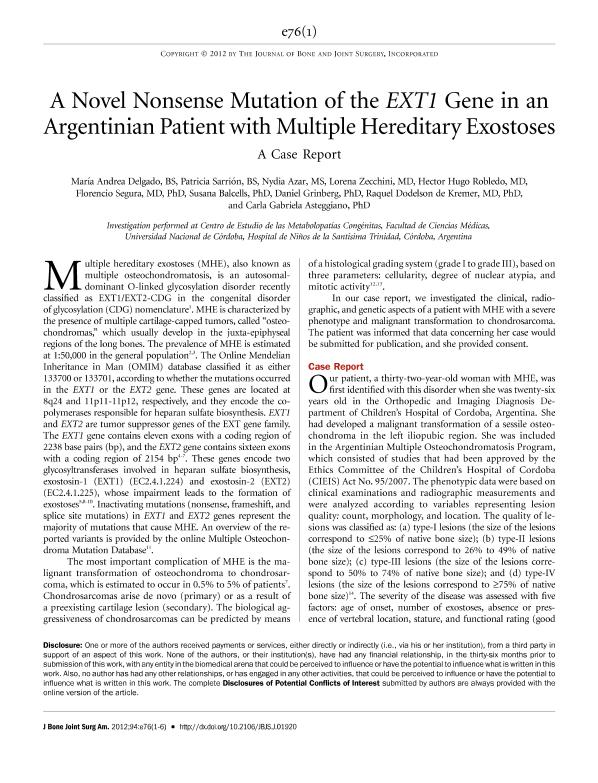Artículo
A novel nonsense mutation of EXT1 gene in an Argentinian patient with Multiple Hereditary Exostoses
Delgado, María Andrea; Sarrión, Patricia; Azar, Nydia Beatríz; Zecchini, Lorena del Valle; Robledo, Hector Hugo; Segura, Florencio Vicente; Balcells, Susana; Grinberg Vaisman, Daniel Raúl; Dodelson de Kremer, Raquel; Asteggiano, Carla Gabriela

Fecha de publicación:
06/2012
Editorial:
Journal Bone Joint Surgery Inc
Revista:
Journal Of Bone And Joint Surgery-american Volume
ISSN:
0375-9229
e-ISSN:
0021-9355
Idioma:
Inglés
Tipo de recurso:
Artículo publicado
Clasificación temática:
Resumen
Multiple hereditary exostoses (MHE), also known as multiple osteochondromatosis, is an autosomal-dominant O-linked glycosylation disorder recently classified as EXT1/EXT2-CDG in the congenital disorder of glycosylation (CDG)nomenclature. MHE is characterized by the presence of multiple cartilage-capped tumors,called “osteochondromas,” which usually develop in the juxta-epiphyseal regions of the long bones. The prevalence of MHE is estimated at 1:50,000 in the general population1,2. The Online Mendelian Inheritance in Man (OMIM) database classified it as either 133700 or 133701, according to whether the mutations occurred in the EXT1 or the EXT2 gene. These genes are located at 8q24 and 11p11-11p12, respectively, and they encode the copolymerases responsible for heparan sulfate biosynthesis. EXT1 and EXT2 are tumor suppressor genes of the EXT gene family. The EXT1 gene contains eleven exons with a coding region of 2238 base pairs (bp), and the EXT2 gene contains sixteen exons with a coding region of 2154 bp3-6. These genes encode two glycosyltransferases involved in heparan sulphate biosynthesis, exostosin-1 (EXT1) (EC2.4.1.224)and exostosin-2 (EXT2) (EC2.4.1.225), whose impairment leads to the formation of exostoses4,7-9. Inactivating mutations (nonsense, frameshift, and splice site mutations) in EXT1 and EXT2 genes represent the majority of mutations that cause MHE. An overview of the reported variants is provided by the online Multiple Osteochondroma Mutation Database10. The most important complication of MHE is the malignant transformation of osteochondroma to chondrosarcoma, which is estimated to occur in 0.5% to 5% of patients6. Chondrosarcomas arise de novo (primary) or as a result of a preexistingcartilage lesion (secondary). The biological aggressiveness of chondrosarcomas can be predicted by means of a histological grading system (grade I to grade III), based on three parameters: cellularity, degree of nuclear atypia, and mitotic activity11,12.In our case report, we investigated the clinical, radiographic, and genetic aspects of a patient with MHE with a severe phenotype and malignant transformation to chondrosarcoma.
Palabras clave:
Multiple Osteochondromatosis
,
O-glycosylation
,
EXT1/EXT2-CDG
Archivos asociados
Licencia
Identificadores
Colecciones
Articulos(CCT - CORDOBA)
Articulos de CTRO.CIENTIFICO TECNOL.CONICET - CORDOBA
Articulos de CTRO.CIENTIFICO TECNOL.CONICET - CORDOBA
Citación
Delgado, María Andrea; Sarrión, Patricia; Azar, Nydia Beatríz; Zecchini, Lorena del Valle; Robledo, Hector Hugo; et al.; A novel nonsense mutation of EXT1 gene in an Argentinian patient with Multiple Hereditary Exostoses; Journal Bone Joint Surgery Inc; Journal Of Bone And Joint Surgery-american Volume; 94; 11; 6-2012; 761-766
Compartir
Altmétricas



